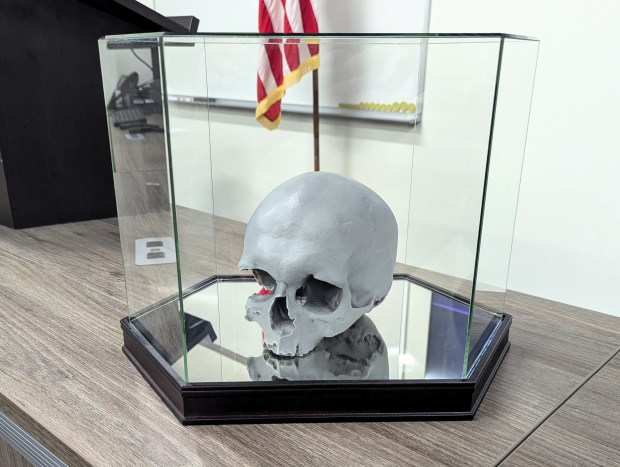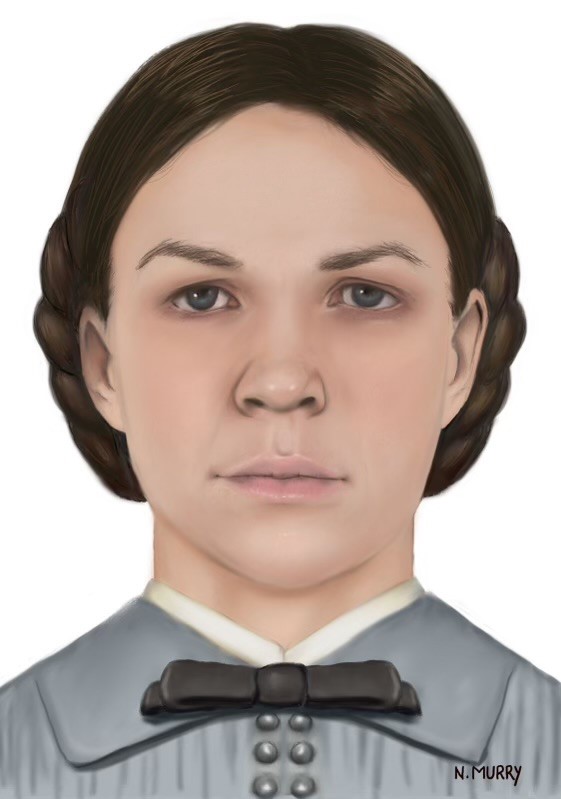The Kane County Coroner’s Office has determined the identity of the person whose skull was found in the late 1970s hidden behind the wall of a Batavia home, officials announced Thursday.
The partial skull was identified as that of Esther Granger, who died at age 17 in Merrillville, Indiana, according to Coroner Rob Russell. He said during a press conference that Granger died soon after giving birth to her first child in 1865.
Kane County Board Chair Corrine Pierog called the skull’s identification an “incredible historical moment.”
Granger was born on Oct. 26, 1848, and got married at age 16 to Charles Granger, Russell said.
She was originally buried in Merrillville, and it is not known how exactly her skull ended up hidden behind the wall of a home in the 200 block of East Wilson Street in Batavia that was built in the 1850s, according to Russell. However, a “common-sense theory” supported by records and “good reason” is that she was the victim of grave robbing, he said.
It is possible someone who was studying medicine lived in the home, and that person wanted a piece of a body for study, according to Russell. Then, the person likely hid the skull in the wall because they knew the consequences of having it, he said.
At that time, grave robbing was common because it was profitable, but it was not without its dangers, Russell said. While law enforcement agencies often did not enforce grave robbing laws, people would instead turn to vigilante justice to stop the practice, he said.
One such act of vigilante violence about grave robbing — the 1849 Richard’s Riot — took place nearby in St. Charles, but it was not connected to Granger, Russell said.
Batavia Mayor Jeff Schielke, who has also co-authored books on local history, said at the press conference that there are no records of anyone in town knowing Granger or having any relation to her.
“She’s kind of a mystery to us,” he said.
The skull was found in November 1978 by James Skinner, who was remodeling his house on East Wilson Street, according to Russell. Skinner immediately called the Batavia Police Department, which launched an investigation into the person’s identity, he said.
The investigation was “incredibly thorough” but police did not have access to the same types of DNA tests and genealogical records as they do today, so little new information was uncovered, Russell said.
A university professor at the time estimated that the skull likely came from a young woman around age 20 who died sometime before 1900, so police searched for missing persons records matching that time period and description, but nothing was found, he said.
The skull somehow ended up in storage at the Batavia Depot Museum, but neither police nor museum records explain why it was sent there, officials said. Batavia Police Chief Shawn Mazza said a detective spoke with several investigators who would have worked on the case in the 1970s, but none remembered how or why the skull would have been sent to the museum.
Employees of the museum found a box holding the skull on March 10, 2021, and they immediately called the Batavia police to report the finding, Russell said.
Employees were completing a “comprehensive audit” of the museum’s collections ahead of the reorganization and relocation of artifacts when the skull was found, according to a statement distributed to members of the media by the Batavia Park District at the press conference.
Batavia police found the original report from 1978 but did not find any additional information, Russell said. Then, they turned the skull over to the Kane County Coroner’s Office, which launched its own investigation, he said.

According to Russell, the investigation was handled by his office’s Cold Case Team, which was started in 2015.
Eventually, investigators learned about Othram Laboratory, which offered a relatively new DNA testing method known as Forensic Investigative Genetic Genealogy, Russell said. The lab looked at the skull and was able to obtain DNA that could be used to create a profile, which could then be run through its database to identify the person’s family members, he said.
Near the end of 2023, Russell’s office asked the community to help crowdfund the procedure, Russell said.
Othram Laboratory’s Michael Vogen said the entire procedure, which included the lab work to extract the DNA, building the DNA profile and uploading the DNA to a genealogy database to match results to known family members, was paid for using around $7,500 of crowdsourced funds.
This case is the oldest the laboratory has ever worked on, Vogen said.
The DNA testing found a match, which included a family tree with living relatives, according to Russell. One of those living relatives, Granger’s great-great grandson Wayne Svilar, agreed to do DNA testing to confirm the finding, and it was a match, he said.
Granger’s partial skull was cremated and laid to rest on Aug. 22 at West Batavia Cemetery with the permission of her family and with Svilar in attendance, according to a media handout from the press conference. The city of Batavia paid for all burial expenses, the handout stated.
It is unclear where exactly the rest of Granger’s body is located, Russell said during the press conference.
Recently, a 3D-printed resin replica of the skull was completed by 3D Resin Solutions of South Elgin alongside a professionally hand-drawn likeness of what Granger likely looked like based on the skull, which was done by forensic artist Natalie Murray, according to Russell.
Svilar, who lives near Portland, Oregon, attended the press conference through online video conferencing. He did not believe the Coroner’s Office investigators when they first called about the skull, thinking it was some sort of scam, but now he feels a sense of closure, he said.
“I wish my mom was still here so that I could tell her this story. She’d love it,” Svilar said.
rsmith@chicagotribune.com




